| INTERVIEW WITH IAN STUART
|
|
 | Ian Stuart wrote the script that would become The Pit. Though memorable for the psychological problems exhibited by the main character, it was intended to be a serious look at an even younger boy with mental problems.
Interview Date: 17 February 2007
|
|
| Andrew:
| What is your background and how did you get involved with "The Pit?"
|
| Ian Stuart:
| I was a child actor from age 11 and by my early twenties was directing major stage plays such as "Murder In The Cathedral", "Hadrian VII" and "Royal Hunt Of The Sun". Then I linked up with Director Jan Steen and after an off-Broadway production of Chaucer's "Canterbury Tales" we went into films and television. I ended up producing 135 different films and television programs of which "Teddy" (released as "The Pit") was one of two features.
I wrote the script after two experiences triggered the idea. First a friend who is now the world's leading ventriloquist told me about communicating with psychotic children through the use of a ventriloquist dummy (they would communicate with the dummy and ignore his presence as if he wasn't in the room) and another friend, a child psychiatrist told me about a little boy who would draw nasty little fantasy creatures he thought he could command. He would send them after people he didn't like or who mistreated him and when the little creatures ostensibly eliminated these people, they would cease to exist as far as he was concerned. They could be physically in the same room and no longer had any reality. He refused to recognize their existence.
| |
| Andrew:
| From what I know, your script described the Tra-la-logs as fictional creatures that lived entirely inside of Jamie's head, but they are real monsters in the movie. Did you make that change or was it altered after you delivered the final copy?
|
| Ian Stuart:
| Jamie incorrectly called them "Troglodies" when what he meant to say was Troglodytes. The pit in the forest was real, but there was nothing at the bottom except creatures created in the child's imagination. It was, I presume, the director's idea to change the word to "Tra-la-logs" which I found unnecessary and silly. A small pronunciation error is one thing but Tra-la-logs insults his intelligence. Over time, the imaginary creatures became so real to Jamie that he insisted they were real and when his babysitter/caretaker became frustrated at this nagging insistence and slapped him, everything in the film from that instant until the final scene in the doctor's office occurs only in his mind.
| |
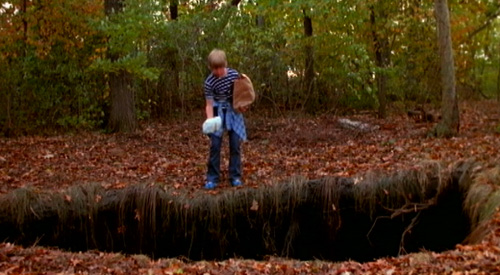 | "Jamie incorrectly called them 'Troglodies' when what he meant to say was Troglodytes. The pit in the forest was real, but there was nothing at the bottom except creatures created in the child's imagination."
Listen to Jamie talk about the Tra-la-logs.
|
|
| Andrew:
| If the murders were originally delusions by Jamie, the ending must have been different. He could have woken up from his daydream, leaving it open to the viewer what he would really do.
|
| Ian Stuart
| He could have, but was genuinely psychotic and continued to believe his delusions. At the end we know that nobody who died is actually dead and are all busily going about their lives as they always did. The only question left in the minds of the audience should have been: Did Jamie actually go out to the country, meet the little girl and get pushed into a pit just as he had done to others? This "tag on" was deliberate - to leave the audience wondering how real any of it was.
| |
| Andrew:
| Jamie was a seriously troubled boy. How did you come up with the character and what were his motivations? The movie did not provide much background about the cause(s) of his social problems.
|
| Ian Stuart
| Jamie is a combination of my ventriloquist friend's experiences, the psychiatrist's patient and my research. There was much more in the original script giving credence to his condition but it was all cut out as too "intellectual" for a horror film.
| |
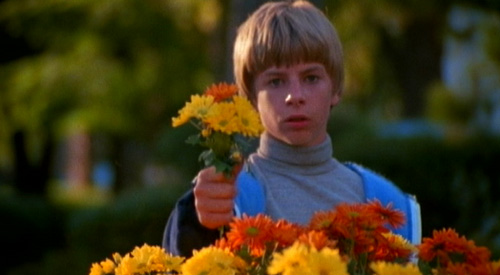 | "Jamie is a combination of my ventriloquist friend's experiences, the psychiatrist's patient and my research."
|
|
| Andrew:
| Writers will often have a good mental picture of the characters in their mind. Did you have any input on the casting? Were any of the cast drastically different from the characters you had established while writing the script?
|
| Ian Stuart
| This is the major problem with the film. Jamie was 8 or 9 and I found five boys that age who could play the role. However, when the director came on board and I handed their pictures and resumes over to him and gave him extensive notes on each, he didn't meet with a single one of them. On the "Move aside, it's my film now." basis, he discarded them all and cast a 12 year old who looked 14. I liked Sammy Snyder and he did his best with the part, but twelve is just too mature for much of his behaviour, and using a boy of that age with the body of a 14 year old completely changed the relationship between him and the babysitter.
| |
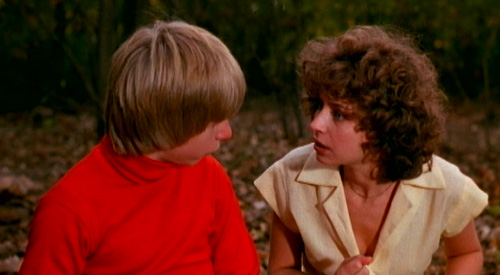 | "...using a boy of that age with the body of a 14 year old completely changed the relationship between him and the babysitter."
|
|
| Andrew:
| Eight or nine is a young age for a child actor, but you obviously found a handful you felt could play the part. What sort of challenges are there in casting an actor that young for a part like this? I guess that some parents would worry.
|
| Ian Stuart
| I have done a lot of work with children from a 26 week children's television series "The KangaZoo Club" to touchy-subject crime prevention films like "Child Molesters: Facts & Fiction" and I should tell you that child actors almost always come from agencies that have previously tested the child's abilities. They also have their parents' agreement and support in pursuing an acting career. Even if a parent is not in the room during the audition (that tends to intimidate the child more than performing for a casting agent or director) they are protectively nearby and are inevitably spoken to after the audition. You treat children as actors and they react like actors. Acting is one of the few arenas in the world where people of all ages - 9 to 90 - are treated as peers and equals. Then, if the audition proves the child can actually do the part and are right for it, you discuss it at length with them, their parents and their agent and decide if "callbacks" or other final auditions are necessary to make an actual choice.
| |
| Andrew:
| Jamie's relationship with Teddy was also an integral part of the movie. Did that survive largely intact or were there major changes to what you had laid out?
|
| Ian Stuart
| His belief that his teddy bear was somehow alive and carrying on conversations with him remained basically as written. It wasn't alive of course. And didn't talk to anyone but Jamie. It was just a stuffed toy.
| |
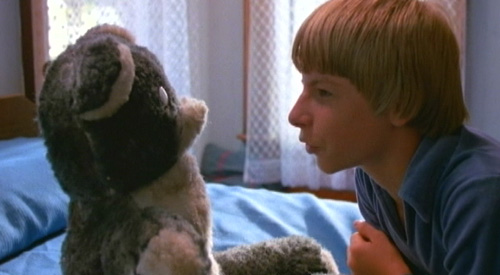 | "His belief that his teddy bear was somehow alive and carrying on conversations with him remained basically as written."
|
|
| Andrew:
| How about the Troglodytes? Even though they were monsters that lived inside of Jamie's head, you must have had a mental picture of them.
|
| Ian Stuart
| Yes, small, shadowy creatures with yellow eyes like wolves that a child might imagine lurking in the closet (or the pit in the forest) and were never really seen except as threatening shapes. The minute they come out into the sunlight as dwarfs in suits the menace is totally lost and the effect degenerates into the ludicrous.
| |
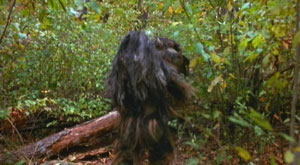 | "The minute they come out into the sunlight as dwarfs in suits the menace is totally lost..."
Click here for a short video of the creatures.
|
|
| Andrew:
| Ever stop by to see any of the actual on-site filming?
|
| Ian Stuart
| No, the producer had me writing another film in Toronto while he was shooting "The Pit" in the US.
| |
| Andrew:
| When did you first see the movie? As a whole, what did you think of it?
|
| Ian Stuart
| I first saw it as a VHS tape and was totally disappointed because it lacked sensitivity, subtlety and any form of class and the creatures were - well - a joke.
| |
| Andrew:
| Was there anything lost between what you wrote and what the viewer sees when they watch "The Pit?" With the change from delusion to real monsters, it makes me think that the movie had another purpose. It does not seem that you intended it to be a monster movie.
|
| Ian Stuart
| The movie was indeed intended as a horror film that accurately portrayed the mind of a psychotic child with major delusional beliefs. It was also supposed to reflect the world seen from the mind of such a child. But you know what it became. The producer - who had the screenplay read by a consulting psychiatrist before he agreed to make the picture - told me after everything was said and done: "You wrote a great script, Ian, and we turned it into just another Grade "B" movie."
| |
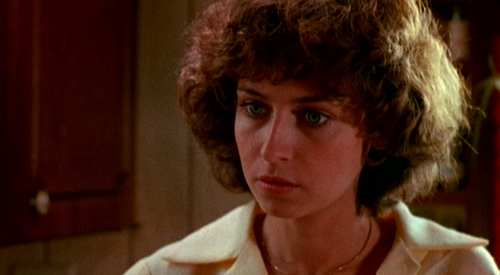 | "The movie was indeed intended as a horror film that accurately portrayed the mind of a psychotic child with major delusional beliefs."
|
|
| Andrew:
| Do you still work in film or theater? If so, tell us about your current projects.
|
| Ian Stuart
| Yes, I do. I am concentrating on screenwriting now and have written another (this time realistic) horror film "Skillings' Mountain"; the thriller "Moon In Scorpio" to star Christopher Lee; the historical drama "Under The Black Flag" about the lives and times of the Caribbean Pirates Anne Bonny and Mary Read; a "Deliverance II" style film "Defiance!" where the people going down the river are women; "Encore!" to celebrate the 30th anniversary of the death of Elvis Presley; "National Anthem" about a man who creates his own island nation and so on. I most recently wrote the dinner theatre "Wise Guys"; re-wrote the very unusual fantasy drama "Beyond The Mirror" whose lead character (and antagonist) is Abaddon, the Angel of the Abyss from Revelation 9:11 and am working on "Burning Torch" the story of Queen Lili'uokalani, the last constitutional monarch of Hawaii.
| |
| Andrew:
| You have created a sizeable number of works. Do you have a favourite, as it was written, and why? Along those lines, which do you believe turned out the best on the stage or screen?
|
| Ian Stuart
| I think "Under The Black Flag" is my best script. Of my produced work I can cite the feature length documentary "The Highland Regiments" shot over two years in Canada and the United States - it's my heritage - and the play "Hadrian VII" about an obscure Englishman who, through a set of most unlikely circumstances, becomes Pope and assumes the name Hadrian VII.
| |
| Andrew:
| Open discussion; is there anything you would like to say?
|
| Ian Stuart
| Screenwriters should be consulted on casting and major directorial decisions in the making of their films if the producers expect to come up with a result that bears any resemblance to what was on the page. A film script is a blueprint - much like an architect's drawings - but if contractors took the liberties that producers take with screenplays, not one architecturally designed building would still be standing. They would all have collapsed long ago and many would fall apart before the doors were opened.
Also, I may write "The Pit II" some day. I've had dozens of requests to do so from people who e-mail me, treat "The Pit" as a cult film and seem to think it was not as bad as I do. Most saw it as younger teenagers and found it had an un-nerving effect on them. They always want to know if there was something else going on in that film that wasn't obvious to the average viewer. I tell them there was - the missing component the director never realized. But he inadvertently included just enough of it to leave viewers wondering.
| |
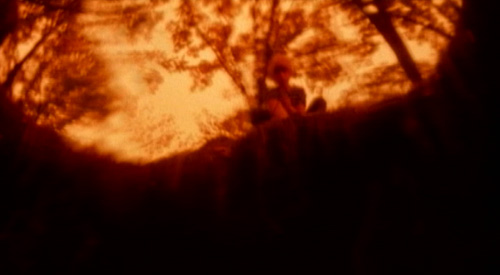 | "I first saw it as a VHS tape and was totally disappointed..."
|
|
I would like to give a kind thanks to Mr. Stuart for making time for the interview. Maybe, with Hollywood's addiction to remaking movies, a producer will take interest in filming "The Pit" as it was intended. With the right touch, it could be a very surreal horror film.
|
|
